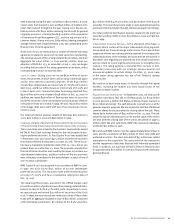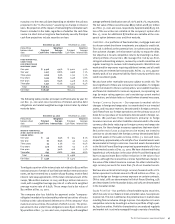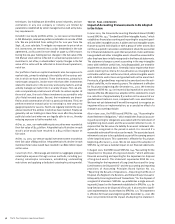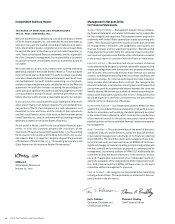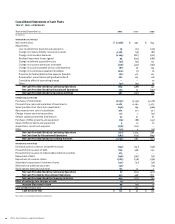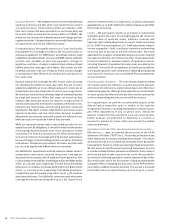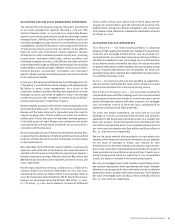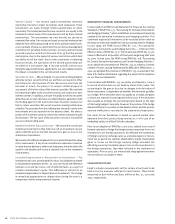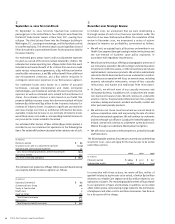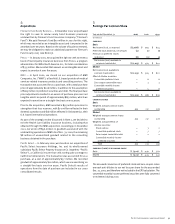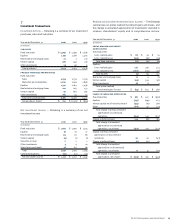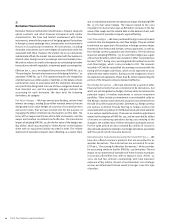Travelers 2001 Annual Report Download - page 47
Download and view the complete annual report
Please find page 47 of the 2001 Travelers annual report below. You can navigate through the pages in the report by either clicking on the pages listed below, or by using the keyword search tool below to find specific information within the annual report.
The St. Paul Companies 2001 Annual Report 45
1
Summary of Significant Accounting Policies
Accounting Principles – We prepare our financial statements in
accordance with United States generally accepted accounting
principles (“GAAP”). We follow the accounting standards established
by the Financial Accounting Standards Board (“FASB”) and the
American Institute of Certified Public Accountants (“AICPA”).
Consolidation — We combine our financial statements with those
of our subsidiaries and present them on a consolidated basis. The
consolidated financial statements do not include the results of
material transactions between us and our subsidiaries or among
our subsidiaries. Certain of our foreign underwriting operations’
results are recorded on a one-month to one-quarter lag due to time
constraints in obtaining and analyzing such results for inclusion in
our consolidated financial statements on a current basis. In the
event that significant events occur in these operations during the
lag period, the impact is included in the current period results.
During 2001, we eliminated the one-quarter reporting lag for certain
of our primary underwriting operations in foreign countries. The
effect of reporting these operations on a current basis was a
$31 million increase to our pretax loss on continuing operations.
Related Party Transactions — The following summarizes our related
party transactions.
Indebtedness of Management — We have made loans to certain
executive officers for their purchase of our common stock in
the open market. These are full-recourse loans, further secured
by a pledge of the stock purchased with the proceeds. The loans
accrue interest at the applicable federal rate for loans of such
maturity. The total amount receivable under this program, included
in “Other Assets” was $10 million at Dec. 31, 2001 and $13 million
at Dec. 31, 2000.
Indebtedness of Venture Capital Management — We have made
loans to certain members of management of our Venture Capital
investment operation. The loans are secured by each individual’s
ownership interest in the Venture Capital LLCs, and accrue interest
at the applicable federal rate for loans of such maturity. The total
amount receivable under this program, included in “Other Assets”
at Dec. 31, 2001 and 2000, was $6 million and $3 million, respectively.
Discontinued Operations — In 2001, we sold our life insurance
operations; in 2000, we sold our nonstandard auto business; and
in 1999, we sold our standard personal insurance business.
Accordingly, the results of operations for all years presented reflect
the results for these businesses as discontinued operations.
At Dec. 31, 2000, our consolidated balance sheet reflected the
$587 million in net assets of our life insurance operations in
“Other Assets.”
Reclassifications — We reclassified certain amounts in our 2000
and 1999 financial statements and notes to conform with the 2001
presentation. These reclassifications had no effect on net income,
or common or preferred shareholders’ equity, as previously reported
for those years.
Use of Estimates — We make estimates and assumptions that have
an effect on the amounts that we report in our financial statements.
Our most significant estimates are those relating to our reserves for
property-liability losses and loss adjustment expenses. We
continually review our estimates and make adjustments as
necessary, but actual results could turn out to be significantly
different from what we expected when we made these estimates.
accounting for our property-liability
underwriting operations
Premiums Earned — Premiums on insurance policies are our largest
source of revenue. We recognize the premiums as revenues evenly
over the policy terms using the daily pro rata method or, in the case
of our Lloyd’s business, the one-eighths method. Lloyd’s premiums
are compiled from quarterly reports. To “earn” these written
premiums we assume that they are written at the middle of each
quarter, which results in eight earning periods in each year.
We record the premiums that we have not yet recognized as
revenues as unearned premiums on our balance sheet. Assumed
reinsurance premiums are recognized as revenues proportionately
over the contract period. Premiums earned are recorded in our
statement of operations, net of our cost to purchase reinsurance.
Insurance Losses and Loss Adjustment Expenses — Losses
represent the amounts we paid or expect to pay to claimants for
events that have occurred. The costs of investigating, resolving and
processing these claims are known as loss adjustment expenses
(“LAE”). We record these items on our statement of operations net
of reinsurance, meaning that we reduce our gross losses and loss
adjustment expenses incurred by the amounts we have recovered
or expect to recover under reinsurance contracts.
Reinsurance — Written premiums, earned premiums and incurred
insurance losses and LAE all reflect the net effects of assumed and
ceded reinsurance transactions. Assumed reinsurance refers to our
acceptance of certain insurance risks that other insurance compa-
nies have underwritten. Ceded reinsurance means other insurance
companies have agreed to share certain risks with us. Reinsurance
accounting is followed for assumed and ceded transactions when
risk transfer requirements have been met. These requirements
involve significant assumptions being made related to the amount
and timing of expected cash flows, as well as the interpretation of
underlying contract terms.
Notes to Consolidated Financial Statements
the st. paul companies


